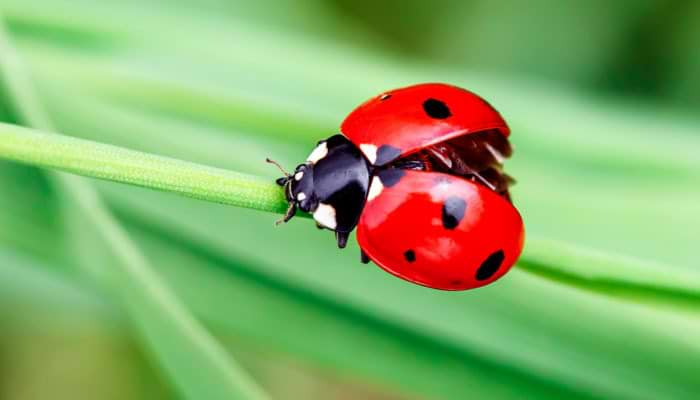
© Srdjan / Adobe Stock
Dating back to the 18th century, a famous poem about ladybirds was chanted by many of us when we were children. The nursery rhyme, "Ladybird, ladybird", is rather cruel if we think about its lyrics in a literal sense - an innocent insect's house and family are destroyed: Ladybird, ladybird, Fly away home, Your house is on fire And your children all gone; All except one And that's little Ann, And she has crept under The warming pan. The poem from the Mother Goose Poetry Foundation is believed to date from around 1780, when the first book of nursery rhymes attributed to "Mother Goose" was published. The title has caught the imagination of publishers and the public for centuries, although no-one knows its exact origins. In illustrations, Mother Goose has been depicted as an "old crone", some of which can be quite scary. The ladybird nursery rhyme, describing the demise of a family of the small red and black insects, has turned out to be very apt. However, it isn't fire that's destroying the UK's ladybird population - it's down to the introduction of an invasive species from Asia, which is gradually wiping out our native species. Life of a ladybird The ladybird was once a familiar sight in the English garden - it remains an important part of our natural wildlife. People love ladybirds because they are attractive and harmless, bringing a dash of colour to our garden with their distinctive red body and black spots. Farmers love them as well, as they eat aphids and other pests that eat plants. Ladybirds have their distinct colouring for a reason - the bright colours are a defence mechanism to warn other creatures not to eat them. There are more than 40 UK species of ladybird, but the two main types are the two-spot and seven-spot varieties. You may not see as many ladybirds in winter, as the cold weather makes them inactive, so they may huddle together in groups, tucked away in the garden, to try and keep warm. Seven-spot ladybirds spend winter hidden away in cracks in tree bark, or in the trunks, while the two-spot variety sometimes make their way indoors and have been found in people's attics, or hiding in window frames and curtain-folds. They emerge in April to start spending their time in the garden again. They are amazing in that they may not eat for around seven or eight months during hibernation. They need to eat very well during the summer months to ensure they don't starve in winter. They eat aphids and nectar from plants such aa buddleia, honeysuckle and rose bushes. Dwindling numbers Unfortunately, ladybird numbers have been dwindling in recent years, mainly due to the threat posed by the harlequin ladybird - an invasive species introduced to Europe from Asia. It was deliberately introduced to North America in the 1980s to control aphids and stop them from feeding on crops. It is now America's most prevalent ladybird. It arrived in Britain in 2004 - an accidental occurrence after it was blown over from Europe. While it took grey squirrels a century to spread throughout Britain, damaging our native red squirrel population, it took the harlequin ladybird less than ten years to do so! Harlequins have around 100 different colour patterns and it can be hard to distinguish them from the UK's seven-spot ladybird. The harlequin is unusual in that it doesn't stick to one kind of food. Once it has finished eating aphids, it will then eat other ladybirds' eggs and larvae. It also eats caterpillars and the eggs of butterflies and moths. As a result of its voracious appetite, it is posing a big threat to our native ladybirds, depriving them of food. It is cited as the main reason why Britain's two-spot ladybird in particular is becoming increasingly scarce. There have also been reports of harlequin ladybirds taking over people's houses and other buildings by hibernating in great numbers. Cases have been reported of thousands of ladybirds hibernating indoors over winter and then becoming active in spring and trying to find a way out of the house. Although not dangerous to people, they can become a nuisance if an infestation suddenly becomes apparent in a dwelling. Environmental changes If you're a keen gardener, you may have seen ladybirds in your garden. Make the most of them, as a study by the Centre for Ecology and Hydrology in Oxfordshire shows ten of Britain's 40 native species of ladybird have gradually declined in recent years. Scientists have recorded more than 25,000 records of the harlequin ladybird across the British countryside, but they say that changes to the rural habitat and also climate change have contributed to the decline. Fears have been raised that if ladybird numbers drop significantly, this will affect the food chain, as predators who feed on ladybirds will also decline because they won't have as much food. Scientists say the moral to the story is not to tamper with nature by moving species to different countries without studying what the long-term impact of such a move might be. MA Grigg’s country store stocks a large selection of clothing that is suitable for gardening, including Wellington boots for men, women and children. We also stock designer brands of Wellies, such as Hunter. Please don't hesitate to get in touch for more details.




